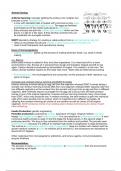Summary
OCR A level Biology Summary: Cloning and Biotechnology
- Module
- Cloning and Biotechnology
- Institution
- OCR
Summary notes for OCR A specification A-level biology Cloning and Biotechnology. Helped achieve an A* in 2022. Covers animal cloning, micro-organisms, microbial growth curves, immobilised enzymes and industrial production.
[Show more]



